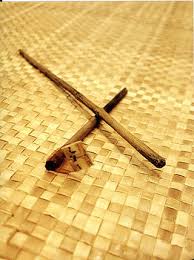Pen


Paper

The Pe'a
Nobody knows the exact origin of this ancient form of writing. Legend has it that two Fijian women swam to Samoa with a basket of tatooing tools, singing as they went. When they arrived, a chief recognized their artistic skills, and the art of tatau was born.
Receiving a pe'a is a rite of passage, a symbol of manliness in Samoa. It is not an easy process. Starting on the back above the waist, the tatooist forces ink into the skin using sharp combs made out of shark teeth or bone. Creating a pattern of lines, angles, and intricate designs, the artist works his way down the back and thighs and around to the front, ending at the navel. The process can take days and even weeks or years to complete. Assistants sharpen the combs, prepare the ink, and wipe the blood away. Usually there is at least a day in between each session with the tatooish to allow the inflammation to go down. the pe'a covers from the knees to above the waist (part of it must be visible above the lavalava).
Significance

Conclusion
Although the ancient Polynesians did not have a written language preserved in books or on pottery, the pe'a is an ancient art that preserves this culture and shows what these peoples value: in this case, strength and the ability to tolerate extreme amounts of pain. The pe'a represents a tradition in which the language of symbols speaks volumes.
I've read that the word tattoo originates from a derivative from the Polynesian word. I'm surprised that the tattoos were applied with a sort of rake so that they were making the patterns in multiple locations at one time. That would have been difficult to properly create.
ReplyDeleteHOLY OUCH!!!!! What a culture! I've read about lots of coming of age ceremonies from other ancient cultures, but none so painful or incredible as this! An interesting thought: often times in our culture, we associate teenage rebellion with getting a tattoo. I wonder if that somehow was inspired by this ancient tradition, as it was a coming of age sort of ceremony. I'm willing to bet it might have been. Once again, I am amazed by the influences of the past that shape our lives today. It's incredible!
ReplyDeleteOh my gosh, so cool. Do the symbols themselves mean anything (besides a symbol of manliness/strength, etc.)? Tattoos know-a-days do, even if the meanings seem silly sometimes (e.g. http://1.bp.blogspot.com/_bQ0SqifjNcg/Swd8LimFGmI/AAAAAAAAIeY/MyBYOZ2E3Pg/s400/head-tattoo-3.jpg).
ReplyDeleteI just have to say that I am glad that is not required for my coming of age. It seems a little intrusive on privacy and painful, not a good combination. I had a couple of friends in high school who got tattoos and they complained about how much it hurt to get ink on a little patch on their wrist. I can't imagine how painful it would be to receive a tattoo that covers somewhere between one third and half of the body.
ReplyDeleteThis is another practice that crosses cultures. Some Native American tribes also used tattoos to show their warrior status and women in some African tribes gave themselves tattoos in order to enhance their appearance.